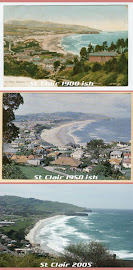Contractors continue to battle sea, sand and snow to shore up a gap under Dunedin's St Clair sea wall.
A relentless sea continued to suck out fill from under the Esplanade yesterday, creating new holes in the pavement and expanding cavities that appeared on Sunday.
A mound of large stones was placed in front of the bottom of the wall in the affected area late on Monday and early yesterday to try to prevent more fill being sucked out under the sea wall by continuing spring tides.
Sheet piling is also being installed to support and protect the wall and infill concrete to further plug the gap is to be poured today.
Dunedin Mayor Dave Cull says the unexpected cost of the work will not affect residents' rates next year, but could in 2014-15.
The Dunedin City Council's roading network manager Peter Standring said the height of the tides was preventing crews accessing the foot of the wall for more than a few hours at a time.
The rock piles had managed to stop much of the problem, but some fill was still being sucked out. It was hoped pouring concrete behind the rocks would stop that.
Crews continued to work on the problem at low tide, about 11pm last night, and would be back again at low tide this morning.
Mr Cull yesterday responded to criticism over the functionality of the sea wall, which was installed by the council in 2004.
People seemed to have forgotten there were many and similar problems with previous sea walls at St Clair, he said.
The first two sea walls, built in the 1880s, lasted only a few years.
A sea wall officially opened in 1913 was covered in by the existing sea wall in 2004 after concerns its base was "kicking out" and after the dumping of massive boulders in front of the wall base following scouring of sand by large swells.
Sinkholes also opened up the Esplanade before the present sea wall was erected.
Mr Cull said the council's focus was to ensure the structure was as strong and protected as it could be for as long as possible.
There was no question of a wall not being at St Clair, so the council had to manage the situation as best it could.
As with any manmade hard surface put in to hold the sea back, issues would be ongoing.
The council would not just rush in and try to "fix" the wall, until the full extent of the problem was known.
He said the cost of fixing the sinkholes would not affect next year's rates because the 2013-14 budget was already set.
Once the Esplanade costs were clear, they could be covered by any surplus at the end of 2012-13, or an overspend could be covered by finding savings or reprioritising projects in next year's roading and maintenance schedule, or rates could be affected in 2014-15.
Council parks manager Lisa Wheeler said there would have to be discussions about how to prevent further erosion.
The council's management plan for the Ocean Beach reserve was focused on protecting the dunes to the north of the sea wall, not the sand in front of it.
The sand at St Clair left and returned almost constantly and the indications were that keeping consistent levels in place would be "far too expensive", she said.


0 comments:
Post a Comment